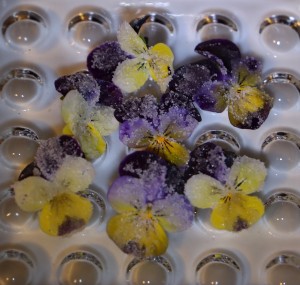 It has been four weeks since the winter solstice and as the days are longer now, sweet violets started flowering in my garden. Their ephemeral beauty is pleasing to the eye, but there is more to flowers than just objects to look at.
It has been four weeks since the winter solstice and as the days are longer now, sweet violets started flowering in my garden. Their ephemeral beauty is pleasing to the eye, but there is more to flowers than just objects to look at.
In recent years I have noted a trend to use fresh, edible flowers or petals in salads and to decorate desserts. Cooked dishes such as fried and stuffed zucchini flowers also made it to mainstream kitchens, while cauliflowers, broccoli and globe artichokes (all of them heads of flower buds!) have been there for a long time.
It is important that flowers you want to preserve are picked straight after they open and when the morning dew has evaporated. If you collect only a little at a time, freeze or dry the flowers until you have enough for your project.
Edible flowers can be made into various preserves, such as dandelion wine and rose petal jam to mention the best known ones.
Many have medicinal uses, like calendula, chamomile, dandelion, Echinacea, elderflower or jasmine flowers; there are many less well known herbal treatments using other flowers, for example, daisies and sweet violets.
Speaking of violets. What will I do with the abundance of them? I have plenty of Sweet violets (Viola odorata) and Heartsease (Viola tricolour) and would like to make something special, so there it is – the recipes!
Violet Syrup
You will need:
- 100g of violet flowers
- 250g of white sugar
- 210g of water
- 1 small lemon, rinsed in boiling water, cut into thin slices
- a sterilised glass jar with a lid
The method:
- Bring the water to boil in a saucepan, add sugar, and stir until it completely dissolves. Set it aside to cool.
- Rinse the flowers quickly in cold water, then put them in the prepared jar together with lemon slices.
- Pour cool sugar syrup into the jar.
- Close the jar and keep in the fridge for two days, stirring from time to time.
- Strain into a sterilised bottle through a dense nylon strainer – do not press the flowers to remove the excess liquid.
- Close the bottle and keep in a fridge.
The syrup adds the aroma of violets and pink colour to drinking water, second kombucha ferments, champagne or icecream.
Frosted flowers
Frosted flowers are used as cake and dessert decorations. Covered with sugar crystals, they look like enveloped in light frost, while retaining their shape and colour.
What you need:
- Fully open, undamaged flowers.
- Edible sticky “glue” – whipped egg white or gum Arabic
- Small, soft brush
- White castor sugar (normal sugar crystals are too heavy for most small flowers) on a small plate
- Optional: citric acid (to be mixed with the “glue”; it helps to retain the colour of purple flowers)
The method:
- Using the brush, paint the underside and then the surface of a flower with the “glue”, then gently dip the flower in sugar – first the top, then the underside. Shake excess sugar.
- Put the flower away face up on a flat surface (baking tray or a dehydrator tray lined with paper).
- Repeat with each flower.
- Dry the flowers either in a dry, dark cupboard or in a dehydrator on a 40 degrees Celsius.
- Store in a glass, closed jar in a cool dark place for up to a month (if using egg white) or up to a year (if using gum Arabic).
- Use to decorate cakes and desserts.
Pickled Magnolia Flowers
- 100 g of petals (about 10 large flowers)
- brine made from 150 ml of coconut vinegar, 50 g of coconut sugar and 1 teaspoon of fine salt.
- Sterilize jars and lids in boiling water.
- Cut petals across into 3-4 mm wide stripes.
- In the meantime combine vinegar, sugar and salt in a pot and slowly heat up, stirring until sugar and salt dissolve.
- Add sliced petals, mix with the pickling brine until all pieces are submerged.
- Put everything in jars, close the lids and after the pickle cools down, keep the jars in the fridge. Allow 2-3 weeks of pickling time before eating.

For other interesting uses of flowers look at Bottling plant fragrances on this blog!


